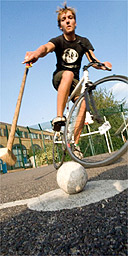
The pre-polo social scene on Brick Lane is not one the regulars at Cowdray Park would recognise. There are no designer frocks or upturned Ralph Lauren collars, and the scruffily hip spectators choose cans of lager over champagne and Pimms. Yet urban bike polo, which has sprung up in cities around the UK, has an unexpected heritage to rival that of its equestrian cousin.
Inspired by street players in New York, the new breed of enthusiasts are reinventing a sport that - despite its inclusion at the London Olympics in 1908 and the hundreds of teams that existed in its heyday in the 1930s - is largely forgotten in Britain. Six months after four friends got together at a basketball court in east London, dozens of would-be players frequently now turn up on Sunday afternoons.
The group started playing after one of them came back from Manhattan raving about a game he had joined in on the Lower East Side, where urban bike polo has been gaining momentum for several years, largely as part of the "fixed gear" scene devoted to the single-gear bicycles favoured by couriers.
But the Brick Lane players soon found they were not alone. Similar groups were also growing in Oxford, where they play in a car park using jumpers for goalposts, Manchester and Brighton.
In rural Kent the Oakenden Pedallers have been playing in the old style - on grass football pitches - for three years, after coming up with the idea in the pub and thinking they had invented it. Last month they all met at a mini-tournament in London. A Pedallers team, despite being that little bit more mature, and "playing in tracksuits", still managed to come second.
"When we first started we had bikes and nothing else," said Brick Lane regular Rakan Budeiri, 22. "We had no idea it had all this history. People went to charity shops and got golf clubs to use as mallets. Then they got broomsticks and attached bits of wood to them.
"We've slowly evolved towards the ultimate bike polo mallet, which is a ski pole with a piece of plastic tubing on the end, sometimes with a rubber handlebar grip added. Lots of people build their own bespoke bikes just for polo. They buy frames on eBay, or use rusty old frames they find in skips, and add parts salvaged from the street or bought at bike jumbles." Many of the players are creative and media types - graphic designers are well represented - but there are also a couple of investment bankers and a stockbroker. The low fixed gear is important: it allows players greater control on court and to pedal backwards. But it is not universal - one regular plays on a shopper and unicyclists have been known to turn up.
At the starting call ("Bicycles ready, pedals ready, go!") the teams of three race from opposite ends of the court towards the hockey ball waiting in the centre circle. Then it's whatever combination of nifty mallet work, clever cycling tricks and more underhand tactics it takes to get the ball in the goal. The first to five wins.
History
Invented in 1891 by retired Irish racing cyclist Richard J Mecredy. Also popular in India, France and the US.
Rules
Only "like to like" contact permissible, ie bike to bike, flesh to flesh, mallet to mallet. Sticking mallet in spokes is ultimate no-no.
Tactics
Whip ball away from tackler by tapping it between wheels. Get in your opponent's way so they fall off.

